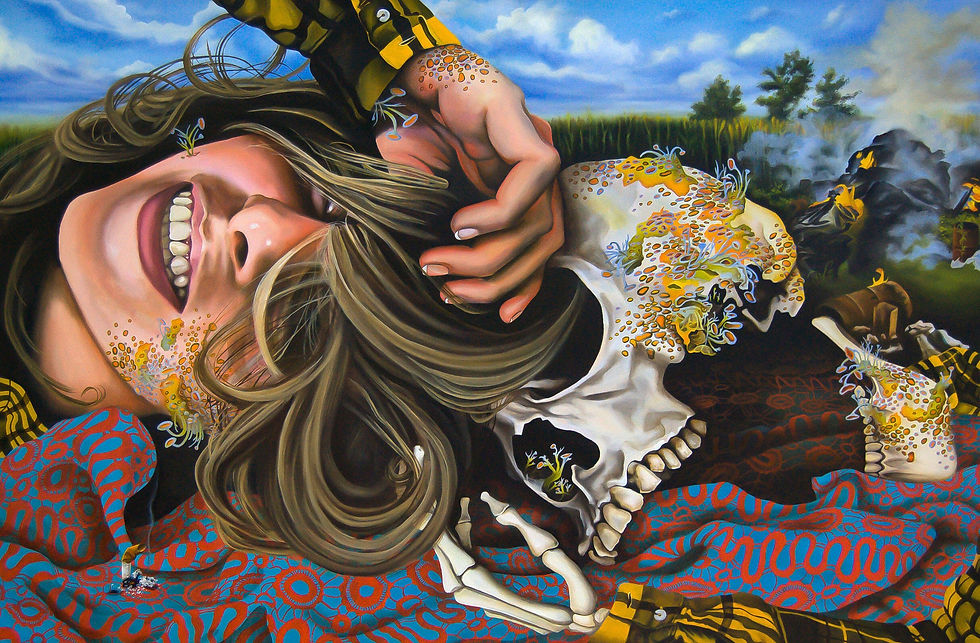
Dreams & Their Edges
Curated by John Seed
Heading 1

David Burke
Marie Cameron
Jon Duff
Shannon Durst
Tara Estrada
Alexandra Evans
Kimberly Glass
Cassie Gnehm
Abbey Golden
Deborah Hamon
Annie Heisey
Phil Irish
Shabnam Jannesari
Michele Johnsen
Lindsay Johnson
Mark Lewis
Ellen Starr Lyon
Re McBride
Claire McConaughy
Marjorie Methven
Daphne Minkoff
Anna Mogilevsky
Keith Pfeiffer
Aaron Pickens
Vanessa Powers
Kimberly Rodey
Zoe Schweiger
Erika Lee Sears
Kristin Sjaarda
Ira Upin
Joshua Walters
Thomas Wharton
Emmanuelle Wilhelm
Sarah Williams
Ashley Williams
JUROR STATEMENT
Dreams and Their Edges
The story goes that when the Surrealist painter Salvador Dali was seeking dream imagery he would intentionally fall asleep holding a spoon over a tin plate. When the spoon fell he would wake up and attempt to paint whatever was in his mind at that precise moment. Known for his uncanny ability to transcribe his dreams onto canvas, one might say that Dali wasn’t just painting dreams, he was also painting their edges. In her book Liminal Dreaming: Exploring Consciousness at the Edges of Sleep, author Jennifer Dumpert writes:
At the edges of consciousness, between waking and sleeping, there's a swirling, free associative state of mind that is the domain of liminal dreams.
Maybe it says something about the times we live in, but the anxious domain of liminal dreaming seems to be providing rich material for a number of artists. As I looked over the 473 Google Drive folders containing the submissions that were refined into this show I was struck by how much of the work had a dreamlike aura.
When Dali was painting his remarkably strange and disturbing dream paintings, he was influenced by Sigmund Freud’s theories about the connections between dreams and the unconscious mind. These days Freud seems antiquated and Surrealism—once presented as a style that liberated the mind and its fantasies— has hardened into a canon. So when I say that the 35 contemporary works that I ultimately selected for this show “dreamlike,” I mean that in a very broad, post-Freudian sense. As weird as Dali was, I think artists much now are much more free and varied in their approaches.
A friend of mine says that dreams are “the motor of your mind idling at the stop sign of sleep,” a sentiment that perfectly expresses the way that I see dreams. Dreaming, once a source of prophecies and spiritual visions, gives our minds a way to work through our experiences, endowing them with mutability and strangeness. In the studio, a blank canvas can be a space to dream—a little or a lot—in a way that lets just about anything filter through into a more enchanted and transient form.
I detected this aura of dreamlike enchantment in many different subjects and approaches. For example, in Claire McConaughy’s Dream Sunset, otherworldly color and fluid brushwork exude the interiority of a dreamworld. Ellen Starr Lyon’s painting of her sleeping son, Metallica Tie Die, offers up a question: does his rumpled t-shirt hint at what he might be dreaming? And Thomas Wharton’s Night Music presents a cosmic dreamscape full of esoteric potential. Can an abstract painting be dreamlike? I say yes. Shannon Durst’s Two Moons, which struck me as almost abstract, is a kind of free-flowing tapestry of consciously and unconsciously generated forms.
Some of the artists in this show may wonder: “What is my work doing here?” The answer is that even if your work isn’t overtly about dreaming it gave me a sense unconscious forces were activating its intensity. You don’t have to fall asleep with a spoon over a tin plate to open the door to your dreams. This show is called Dreams and Their Edges because so many of the artists involved seem to be working on the periphery of dream worlds. Art-making gives us all the chance to explore the alternate worlds and fantasies that our idling minds generate when we close our eyes and make our way towards the unconscious.
*For optimal viewing, view on a desktop or laptop computer.

Untitled 12"x12" Oil on Panel

A Day Oil on board 50 x25 2015

Mantis Prawn Stroll 15x16" Collage on Paper

The Garden Grew like a Garden 55"x67" Oil on Canvas






























